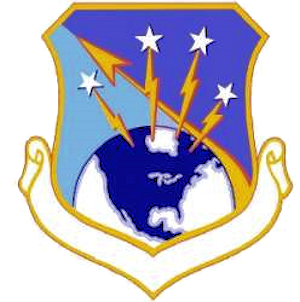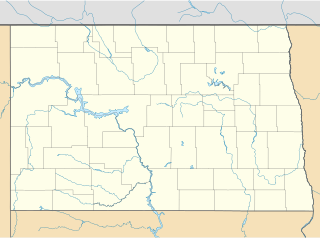This article includes a list of references, related reading or external links, but its sources remain unclear because it lacks inline citations .(December 2012) (Learn how and when to remove this template message) |
| 740th AC&W Squadron | |
|---|---|
Emblem of the 740th Aircraft Control and Warning Squadron | |
| Active | 1953-1962 |
| Country | United States |
| Branch | |
| Type | General Radar Surveillance and Ground Control Intercept (GCI) |
The 740th Aircraft Control and Warning Squadron AKA 740th AC&W Squadron is an inactive United States Air Force unit. It was last assigned to the Minot Air Defense Sector, Aerospace Defense Command, stationed at Ellsworth Air Force Base, South Dakota. It was discontinued on 15 August 1962.

The United States Air Force (USAF) is the aerial and space warfare service branch of the United States Armed Forces. It is one of the five branches of the United States Armed Forces, and one of the seven American uniformed services. Initially formed as a part of the United States Army on 1 August 1907, the USAF was established as a separate branch of the U.S. Armed Forces on 18 September 1947 with the passing of the National Security Act of 1947. It is the youngest branch of the U.S. Armed Forces, and the fourth in order of precedence. The USAF is the largest and most technologically advanced air force in the world. The Air Force articulates its core missions as air and space superiority, global integrated intelligence, surveillance, and reconnaissance, rapid global mobility, global strike, and command and control.

The Minot Air Defense Sector (MADS) is an inactive United States Air Force organization. Its last assignment was with the Air Defense Command 29th Air Division, being stationed at Minot Air Force Base, North Dakota. It was inactivated on 1 December 1963

Aerospace Defense Command was a major command of the United States Air Forces, responsible for continental air defense. It was activated in 1968 and disbanded in 1980. Its predecessor, Air Defense Command, was established in 1946, briefly inactivated in 1950, reactivated in 1951, and then redesignated Aerospace rather than Air in 1968. Its mission was to provide air defense of the Continental United States (CONUS). It directly controlled all active measures, and was tasked to coordinate all passive means of air defense.
The unit was a General Surveillance Radar and Ground Control Intercept (GCI)squadron providing for the air defense of the United States. Its call sign was Rollerskate and was the primary controller site for the 54th Fighter Interceptor Squadron (FIS), call sign Campaign. Rollerskate controllers guided three different Air Force fighters during intercepts while in operation. The F-84G Thunderjet, 1953–1954, F-86D Sabre Interceptor, (the Dog) 1954–1957 and the F-89J Scorpion, 1957–1960. Rollerskate operated MPS-7 Search Radar and MPS-14 Height Finder Radar. Rollerskate intercept controllers were distinguished for being the first GCI site to successfully intercept and technically shoot down Major General Jarred V Crabb during a surprise evaluation of Rollerskate by senior CADF officers. Major General Crabb, who had assumed command of Central Air Defense Force, was flying an F-102 when three of 13 F-86D's were successfully guided to the "SPLASH." General Crabb was on his way to Great Falls AFB with orders for any operational unit to try an intercept him on his route. Rollerskate knew they were to scramble one alert bird in an effort to intercept the general, what they didn't know was four additional flights of three were scrambled without their knowledge. As each flight of three were taking off an ORI team ordered the gate guard not to call the operations room until they entered the radar ops building. This left the officer on duty, Lt. Frank Imel and his Intercept Control Tech S/SGT Charles Diaz, to successfully control all the 13 Dogs. The evaluation officers were amazed by Lt. Imel and his crews performance during the mission. When General Crabb heard the three "SPLASHES" he decided to land at Ellsworth and by saying, "Bullsxxt, I want to see the camera film." After reviewing the gun camera film, General Crabb commended the three pilots and gave a special well done to Lt. Imel. General Crabb agreed he had in fact been shot down. Rollerskate had some of the best GCI controllers in ADC.
Lineage
- Activated as 740th Aircraft Control and Warning Squadron, 1 February 1953 Call sign Rollerskate
- Inactivated, 15 August 1962
Assignments
- 31st Air Division, 1 February 1953
- 29th Air Division, 16 February 1953
- Minot Air Defense Sector, 1 January 1961 – 15 August 1962

The 31st Air Division is an inactive United States Air Force organization. Its last assignment was with Air Defense Command, assigned to Tenth Air Force, being stationed at Sioux City Municipal Airport, Iowa. It was inactivated on 31 December 1969.

The 29th Air Division is an inactive United States Air Force organization. Its last assignment was with Air Defense Command, being stationed at Duluth International Airport, Minnesota. It was inactivated on 15 November 1969.
Stations
- Rapid City AFB, South Dakota
- Re-designated: Ellsworth AFB, South Dakota 1 June 1953-15 August 1962
















